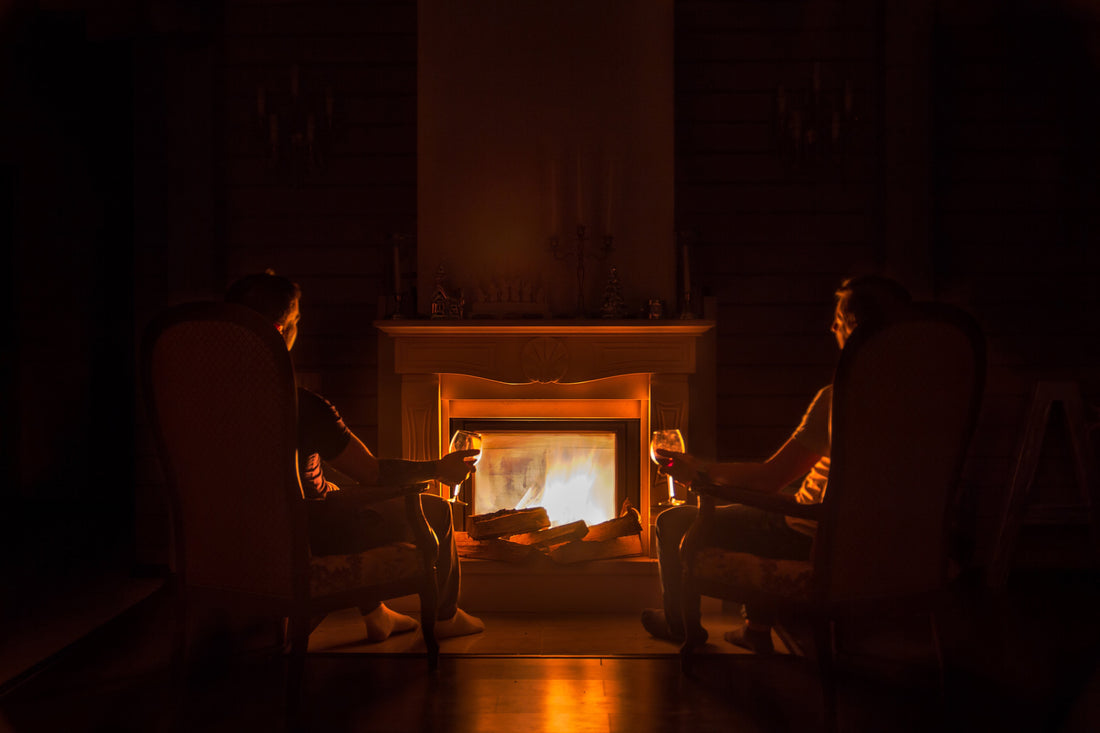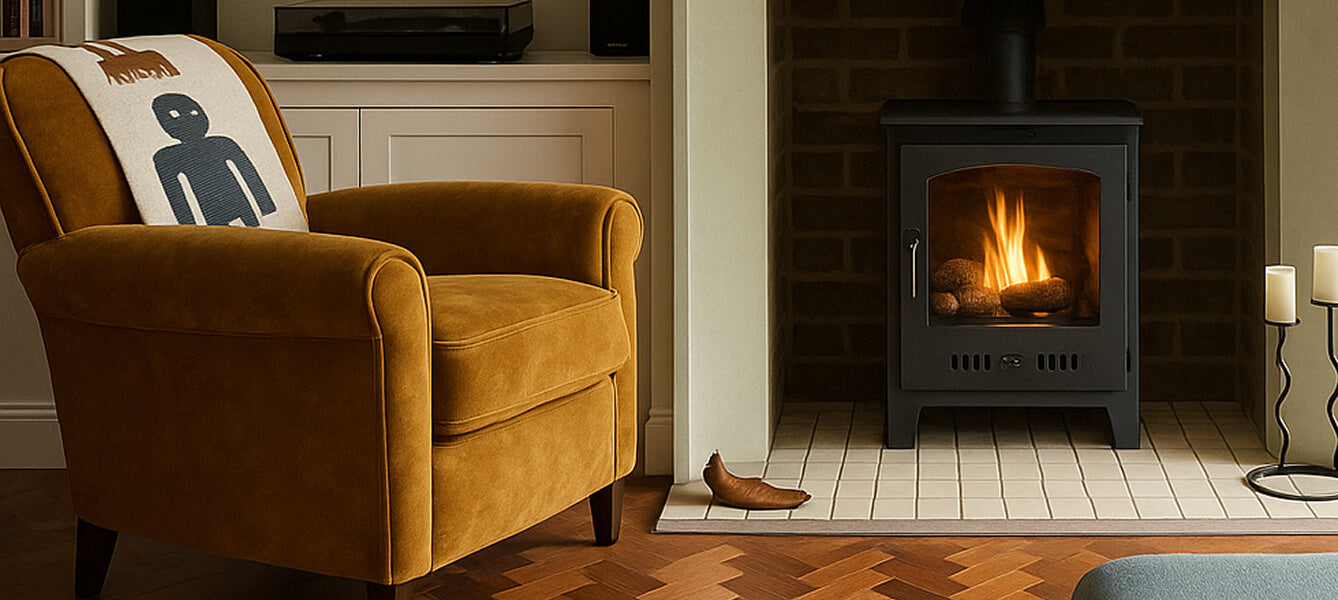
How to Get the Optimal Heating Performance From Your Fireplace
Imagine the scene… you’ve had a long day out in the cold, wet outdoors. You’re looking forward to taking off your coat, getting a warm drink, and relaxing in front of a roaring hot fire.
However, when you turn the fire on, it’s not as toasty as you would like. What do you do?
The heat you get from your fireplace can vary depending on a wide range of factors, plus some fireplaces are naturally more efficient. The good news is that there are some things you can do to ramp up the warmth and feel more relaxed in front of your fireplace.
Let’s look at how to get the best heat from your stove and use your fireplace efficiently, whether using a log burner or a bioethanol fireplace.
The heat performance factors you need to be aware of

All fires need three different elements to burn at an optimal temperature – heat, fuel, and oxygen. This is referred to as the fire triangle. Take any one of these elements away, and a fire will die out.
This means that if you want to get the most efficiency from your fire, you need to make sure it can get enough oxygen, heat, and fuel.
- Heat: To get your fire started and keep it burning bright, you need a reliable heat source, like a match, lighter, or ignition source
- Fuel: To ensure your fire burns at the right intensity, provide a regular, high-quality supply of fuel, like dry logs or bioethanol fuel
- Oxygen: To improve heat performance, make sure there’s enough air circulation around the fire
We’ll look at some of the ways you can improve the heating performance of your fire by taking these factors into account later on in the article.
Which is the most efficient fireplace for heating?

There are many different types of fireplaces, each with its advantages and disadvantages. Some are more efficient when it comes to heat performance than others.
Heat output rating is measured in kilowatt-hours or kWh. The higher this rating, the more heat a fireplace can produce, meaning a warmer room. Let’s look at the heating performance of some of the most popular fireplaces on the market.
|
Type of heater |
Type of fuel |
Advantages |
Disadvantages |
Maximum heat output rating |
|
Electric fire |
Electricity |
Low-cost, easy to use |
Low heat output, not authentic |
2kWh |
|
Gas fire |
Natural gas or propane |
Low-maintenance, low-cost |
Not authentic |
10kWh |
|
Log burner fire |
Wooden logs |
Authentic, cost-effective |
High maintenance, can be dangerous |
8kWh |
|
Bioethanol fire |
Bioethanol fuel |
Clean burning, no emissions |
Slightly lower heat output than log burner fires |
3kWh |
|
Fireplace |
Coal |
Stylish and classic |
Produces smoke and fumes |
8kWh |
|
Pellet stove |
Wood pellets |
Easy to use, environmentally friendly |
Can be noisy, high maintenance |
10kWh |
|
Oil-filled heaters |
Oil |
Efficient to run |
Don’t produce much heat |
2kwh |
Bear in mind that these are average values. As a general rule of thumb, the larger the heater, the higher the heat output rating. However, this doesn’t always mean a large heater is best for optimal heat – we’ll look at this in more detail later.
Customers often ask us if bioethanol fires produce heat, and the answer is, yes, they do! While a bioethanol fire isn’t intended as the primary heat source for your home, it’s a wonderful way to make your living room, kitchen, or even your patio, lovely and warm.
Plus, a bioethanol fire is low maintenance, meaning no running out to the shops to buy logs or getting soot on your hands. We stock a wide range of bioethanol fireplaces, meaning you can choose the perfect one for your home.

The most important thing is that the fireplace you choose suits your home, lifestyle, and budget. A fireplace with a lower heat output rating can still provide enough heat to keep you and your family toasty.
Our top tips for boosting heating performance

We’ve looked at the fires that produce the most heat, but how can you optimise your existing fireplace to make your room warmer? We’ve put together some handy hints and tips for boosting heating performance and using your fireplace efficiently.
Choose the right-size fireplace for your room
A large fireplace can look warm and inviting, but it might not always be the most efficient option for your home. A too-big fireplace means heat dissipates faster, meaning you don’t feel the benefit. Conversely, a too-small fireplace may not produce the heat you want.
Measure your room before you choose the perfect fireplace. The wonderful thing about bioethanol fireplaces is that they come in lots of different shapes and sizes.
Use a fireplace insert
A fireplace insert is a fireproof steel or iron box with an insulated glass front. These inserts can improve heating performance and make your fire more efficient. And the great thing is, you can use them with a wide variety of different fuels.
Why do fireplace inserts make your fire more efficient? They create a closed combustion system that captures heat and pushes it out into the room. Some inserts even have fans to distribute warm air more efficiently.
If a fireplace insert isn’t an option (for example, if you have a stove), or you are looking for more efficiency, there are other options. A heat shield, sometimes called a fireback, is a heat-resistant panel that reflects heat back into the room.
Buy the highest-quality fuel possible
When energy bills are rising and the cost of everyday essentials is climbing, you might think it’s okay to scrimp on fuel for your fireplace. However, this can be counterproductive and lead to poor performance.
It’s always best to buy the highest-quality fuel you can, whether this is logs, bioethanol fuel, or wood pellets. This fuel burns more slowly and for longer, meaning you reap the benefits.
On a similar tangent, avoid burning wet wood, as this produces less heat and more smoke. Always use ‘ready to burn’ logs, which have a lower moisture content.
Insulate your room

It’s not just about your fireplace but the room it’s in. A draughty, poorly insulated room can mean heat exits your living room or kitchen as quickly as your fireplace can generate it.
Thick curtains and rugs can trap heat and make your room feel cosier. Insulating tape and filler can help you block holes in your walls and around your windows and doors.
If you’re in the mood for a big DIY project, insulating your loft is one of the best things you can do to reduce heat loss in your home. This means you don’t just get warmer rooms but also save on your energy bills!
Carry out regular maintenance
It’s essential to carry out an annual service on your car to ensure it performs as well as possible. The same logic applies to your fireplace.
Keeping the components of your fireplace clean and free from contaminants can improve airflow and boost efficiency.
For example, keeping your chimney clean and getting it swept once a year means air can flow freely, meaning more heat and better combustion.
Carry out a quick check before turning your fire on, ensuring all the components are clean, free from damage, and aren’t blocked. This will help you identify any issues that might affect the performance of your fireplace.
Take it slow
If you have a log burner fire, you might be tempted to use accelerants like lighter fuel or gasoline to get it pumping out the heat more quickly. However, this can cause your fire to burn out of control, and produce toxic fumes.
Similarly, don’t throw logs on straight away. Overloading your fire can damage your log burner and means you burn through your fuel too quickly. Wait until you see glowing embers, then add just enough logs to keep the fire going.
Always build your fire slowly, and be mindful of fire safety.
Improving your heating performance shouldn’t be a hassle

No matter which type of fireplace you have in your home, you can optimise heating performance and create fires that produce more heat in just a few simple steps.
We hope you enjoyed this guide to heat performance and heat performance factors.
If you’d like to know more about the different types of fireplaces and how to heat your home like a pro, why not check out our blog?
